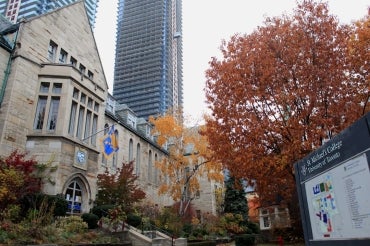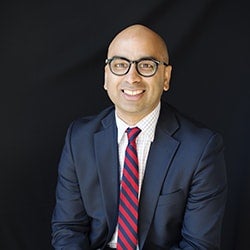Randy Boyagoda on the role of a Roman Catholic college in a "proudly secular public-research university"

Published: October 18, 2016
Professor Randy Boyagoda is principal and vice president of the University of St. Michael’s College in the University of Toronto and holds the Basilian chair in Christianity, Arts, and Letters.
A biographer, novelist and former Scotiabank Giller Prize nominee, he recently wrote about St. Mike's for The Chronicle of Higher Education.
I had a student’s complete attention. This is a rare prize for a professor, never mind for a dean standing at centre court. I had been invited to the varsity field house to deliver an invocation address on the meaning of a college education and was scheduled to speak in the middle of a pep rally. My remarks were sandwiched between a flash-mob dance and the debut of the school mascot.
After proving my bona fides by leading them in the school cheer, I congratulated the members of the incoming class of the University of St. Michael’s College in the University of Toronto on choosing to join an avowedly Roman Catholic liberal-arts college that’s part of a proudly secular public-research university. This double affiliation will not be easy for my students – who include both practicing and nonpracticing Catholics, students of other faiths, and "nones," an especially ironic homonym at a Catholic college – but it creates a great opportunity to develop fresh models of dialogue, even integration, in a world riven by endless conflicts between the sacred and the secular.

I proposed as much that night in the field house, all the while wondering how that one particularly attentive student took in my words. She had an excellent poker face, and she was wearing a hijab. As a publicly committed Muslim, did she feel excluded because some of my remarks were explicitly Catholic? Or did she feel included because she could tell that she was entering an academic community that confidently affirms its own religious identity and practice, and from this source is just as open to those of others, including hers?
Fifty years ago, that kind of affirmation and openness worked very well in Toronto. St. Michael’s College professors like Marshall McLuhan, Jacques Maritain, and Étienne Gilson taught students from their Catholic school and from across the larger secular university what it meant to take a religiously informed view of the leading scholarly, intellectual, and public questions of the day – and what could be discovered in the process.
Gilson, arguably the pre-eminent medievalist of the 20th century, in fact accepted a job offer at St. Michael’s over Harvard because he wanted to be part of both a small Catholic intellectual community and a large research university, a combination that made possible scholarly work and teaching along a cosmopolitan sacred/secular axis. That’s historically interesting and a great story to tell donors and alumni, but it says little to the Class of 2020, young people confronting a larger world in which such binary thinking and practice make for a great deal of mutual suspicion and animosity.
These days, religious interests and commitments rarely play out with much grace or salutary effect on campuses. Religiously affiliated colleges too easily fall prey to stridency and divisiveness in affirming their confessional commitments; nonreligious colleges denude religious experience of its depth and richness either by framing it as the object of exclusively academic study or by confining it to purposefully bland multifaith gathering spaces. There are also historically religious colleges so eager to demonstrate their evolution from dim confessional pasts to the bright secular present that they tend to celebrate most every faith save their own.
There’s a more charitable construal, of course, for these tendencies and practices. I’m not interested in it. I’m more interested in preparing students to integrate their faith and intellectual commitments in ways that are mutually challenging, engaging, and relevant, in and beyond the classroom, and likewise for students without religious commitments to accept the reality, and indeed the potential benefits, of engaging with religiously serious people.
This is absolutely necessary for all concerned, because religion will never disappear from human experience, any more than rejection and critiques of religion will disappear. In other words, we need to move from an elite First World presumption that you’re either religious or you’re not, with all the stereotypical assumptions that flow from those positions, to a situation in which more and more people are confident and capable in being both religiously serious and thoughtfully secular.
But how do you do that if you’re 18 and attending a private Catholic college federated with a public secular university, situated in the heart of one of the world’s most cosmopolitan and diverse cities? Not by going backward, as I discovered. At the conclusion of my invocation address, and mindful that this was a pep rally, I informed the students that in addition to a wildly popular school cheer, St. Michael’s also has a centuries-old chant that remains alive today as part of our Catholic identity and tradition. This chant calls on our patron saint to pray for us. I invited them all to try it out with me – in the original Latin.
The result was a giggling, mumbling mess. Given their inborn millennial suspicion of the pietistic and ideological, they let me know this didn’t feel relevant to them, easy citizens of Drake’s 21st-century Toronto. So I challenged them to join me in making it feel relevant. Then I started spitting DJ beats into the microphone and invited the incoming class to join me in a call-and-response hip-hop version of "St. Michael the Archangel, pray for us."
There was still a lot of giggling, but the voices were louder, and the vibe was joyful rather than awkward. I looked up into the bleachers: That young woman in the hijab was still staring at me, but she wasn’t poker-faced anymore. She was smiling. Was this because her new college principal was making a holy fool out of himself? Or was it because she was down with this playful little bit of evidence that the sacred and secular can in fact intersect in fresh and positive ways on campus, ways that are open to all of the students who have chosen membership in a religious college at a secular university, including her? I think (and pray) that she was smiling for both reasons.
(This article was originally published in The Chronicle of Higher Education on Oct. 16 and is reprinted here by permission.)



